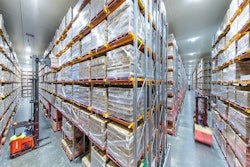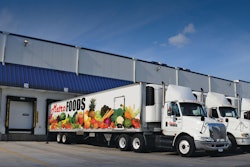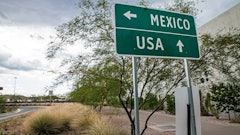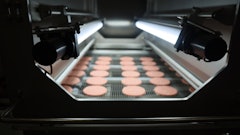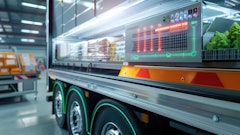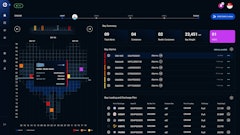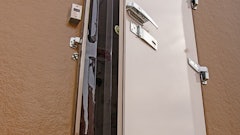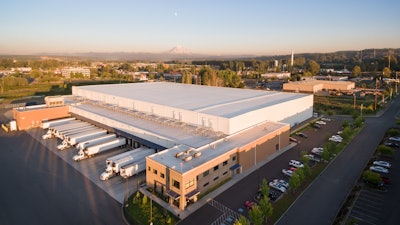
Ensuring the safety of perishable and frozen foods is the No. 1 priority of every cold storage and logistics provider, but the complexity of today's supply chain leaves the cold chain prone to numerous risks. According to Carl Fowler, senior vice president of business development at Americold, labor shortages, capacity constraints, trade uncertainties and changing buying habits are among the biggest challenges providers currently face.
“Ensuring food safety and regulatory compliance is critical, but companies have a pretty good handle on that. The food logistics industry really sets the bar in that regard for other industries, born out of necessity. But [the risk today] is really around the labor issues, capacity constraints and some of the transportation head winds,” Fowler says. “What distinguishes the good providers are the ones who have plans and strong corporate strategies on how we are mitigating those risks on behalf of our clients.”
On both the warehousing and transportation side, a lack of capacity, driven in large part by population growth and changing consumer buy patterns, has increased the demand in temp-controlled distribution.
Log in to view the full article
Ensuring the safety of perishable and frozen foods is the No. 1 priority of every cold storage and logistics provider, but the complexity of today's supply chain leaves the cold chain prone to numerous risks. According to Carl Fowler, senior vice president of business development at Americold, labor shortages, capacity constraints, trade uncertainties and changing buying habits are among the biggest challenges providers currently face.
“Ensuring food safety and regulatory compliance is critical, but companies have a pretty good handle on that. The food logistics industry really sets the bar in that regard for other industries, born out of necessity. But [the risk today] is really around the labor issues, capacity constraints and some of the transportation head winds,” Fowler says. “What distinguishes the good providers are the ones who have plans and strong corporate strategies on how we are mitigating those risks on behalf of our clients.”
Capacity Crunch
On both the warehousing and transportation side, a lack of capacity, driven in large part by population growth and changing consumer buy patterns, has increased the demand in temp-controlled distribution.
Meaning, "there just isn’t enough space to service the ask,” explains Fowler.
This is further exacerbated by the fact that temp-controlled distribution is really capital intensive.
“It’s a big expense, and it requires a high level of sophistication when you’re talking about those large refrigeration systems and what it takes to maintain them,” notes Fowler. “It’s not like standing up a dry, conventional space that is easily transformed to meet various needs. These are purpose-built facilities, and spec build really doesn’t happen.”
Because of that capital requirement, he adds, companies are less likely to lock into a long-term commitment.
“We don’t spec build; we build based on commitment. That makes it difficult for organizations to find that temp-controlled storage space they need, and when they do need it, it’s not always readily available,” Fowler says, noting, “We’re working with our customers to help them plan better and encouraging them to lock into fixed commitments to ensure that space is there to protect them during their peak season swings so they don’t find themselves in a position where they are scrambling to try to find storage space.”
Guaranteed warehousing also eliminates the complications with maintaining inventory across multiple locations and lowers the number of touches and chances for damage and loss.
On the transportation side, the industry is also suffering from a capacity shortfall at the moment, driven by the driver shortage, says Kirk Hoover, senior director of business development at Americold.
“I’ve been in this business a long time, and I have never seen a driver shortage like this in the frozen, temp-controlled business. We’ve always had owner-operators, carriers we could work with, people we could go to. That’s not there today; those resources are drying up, and it’s going to continue to be a real issue as we go forward,” Hoover warns.
In fact, many shippers are already beginning to feel the pressure.
“There just isn’t enough temp-controlled rolling assets to service demand. Some markets you have a 25 to 35 percent carrier call off rate, where loads just aren’t going claimed. If you can’t get your freight moved, it’s awfully hard to service that end customer. It’s really put a lot of pressure on the retailers, manufacturers and distributors to protect the revenue streams,” Fowler adds.
At a regional level, New Orleans Cold Storage (NOCS) is affected by the transportation capacity crunch every day, says Jim Henderson, vice president sales and marketing for NOCS. To meet the challenge, he explains, the cold storage company knows it can’t do it alone.
“At NOCS, our goal is to work closely with our customers to manage these challenges together,” Henderson says. “We understand that flexibility is the key. We can’t have labor standing by 24/7, hoping that trucks show up, so we must communicate schedules and innovate ways to track movement, then plan labor to ensure we manage cost, but also have flexibility to help customers and transportation partners when unforeseen challenges arise.
“For us, it’s all about being good, long-term partners and working closely with customers to plan ahead for potential scenarios. Rather than just saying no when problems arise, we work hard to offer solutions to mitigate costs," he adds.
To that point, Americold’s Fowler agrees. “We can’t just throw our hands up and say, ‘Well, that’s it.’ We’ve had to find alternative solutions to mitigate those risks on behalf of our clients.”
As one the largest players in the space, Americold’s solution has been to use its density to establish consolidation programs.
“The old adage that freight moves freight is certainly true here,” Fowler says. “We are able to use our density and establish programs that are consolidating multiple outbound orders into one, and we are able to use that full truck move, especially between our consolidation hubs, to make attractive lanes for carriers. We’re able to use that size and scale to partner with the carrier partners in our eco-system to secure capacity, and at times, even leverage our own internal infrastructure to bridge some of those gaps as well.”
For example, instead of tendering a carrier from one of its major distribution centers (DCs) with four or five stops and 10 manufacturers on the load, Americold can put one or two stops on a truck. This, in turn, attracts carriers because, Hoover says, it’s an easier run with fewer stops and a quicker turn around. It also increases carrier profitability.
“By building the loads that best suit their needs, we can help our carrier partners increase profitability, while still servicing our customers’ needs for on-time delivery and mitigating our capacity risk,” Fowler explains, adding, “We have one of the largest networks in the country, and it puts us in a position to be able to leverage those freight flows to reduce the number of carrier call offs or no shows.”
Labor Shortage
It’s nearly impossible to talk supply chain without talking labor—and temp-controlled assets are no exception. For one, there is not enough of it. Secondly, the complexities of the cold chain require a certain level of skill.
“The unemployment rate is very low and is having an impact on businesses across the United States. We certainly feel it in our industry,” Fowler says.
The cold chain’s difficult working environment is a major factor, as well as increased competition from e-commerce businesses such as Amazon who continue to invest in large-scale DCs. Technology is helping to solve some of those challenges though.
According to Marc Beasley, vice president of food strategy and business development at Sensitech, a provider of cold chain visibility solutions, “the industry is increasingly focused on adopting technology solutions that help drive automation and streamline processes.”
These technologies include hands-free data capture capabilities provided through wireless and real-time monitoring solutions, collaborative software solutions that help align standards and processes during hand-offs in the supply chain, and data analytics that provide insights to drive efficiency and improvements.
Where providers have high-labor content and labor challenged markets, Americold’s Fowler says there is also a need for increased automation.
“There will always be a need for conventional space because automation is not a one-size-fits-all solution, but where you have high velocity, high touch operations, where you can eliminate redundant work and errors, automation make sense.”
Beasley adds that the nature of supply chains, with multiple hand-offs between suppliers, carriers, DCs and stores, lends itself well to automated tasks.
“The human factor in the process of hand-offs is where we see the greatest risks for cold chains. Lack of training, not understanding or implementing best practices around cold chain, and improper usage of equipment can all result in quality risks, including poor temperature,” he explains.
Trade Uncertainty
In July, The Wall Street Journal reported record amounts of meat and poultry had begun to fill U.S. warehouses amid ongoing trade disputes and surging supplies. Agriculture analysts estimated more than 2.5 billion pounds of beef, pork, poultry and turkey stockpiled in cold-storage warehouses, whose suppliers rely on foreign exports.
Grain farmers are also already feeling the impacts of the Trump Administration’s tariffs, with soybean prices falling from about $10.50 in May to about $8.50 a bushel at press time. China, the world’s largest importer of soybeans, imposed a 25 percent tariff on soybean imports effective July 6, largely in retaliation to the Trump Administration’s tariffs on $34 billion worth of steel, aluminum and other goods the United States imported from China.
And unfortunately the effects of these inventory surpluses will be felt throughout the supply chain.
“As customers try to export and tariffs are being placed on product, inventory swells in an already constrained market make it difficult for our food producers to find space to accommodate that inventory swell as that uncertainty works its way out,” Fowler explains.
Fortunately for Americold, however, through technology and people, Fowler says they’ve been able to create a flexible network in a fixed-asset environment.
“Through visibility tools, when customers’ demand spikes unexpectedly, we have the ability to quickly look across our network and understand where we have space and understand what the impact of storing it there is,” Fowler says. “We can help our customers make good, sound decisions on where to put that inventory quickly to protect their manufacturing and production schedules and help them maintain food safety and product integrity by keeping it at the right temp.”
Hoover adds: “We’re always trying to find an alternative solution for our customers when they get into a situation like that, and fortunately because of our infrastructure, we can typically do that.”
Changing Buying Habits
How people purchase and acquire their food has also created new risk in the food supply chain. Ten years ago consumers were buying everything in bulk, but today the industry is seeing a shift to faster turns, smaller order quantities and growing urban market storage, Fowler says.
“You’re talking about speed, velocity and order size all being impacted, so you have to be a lot more agile and nimble on your replenishment strategies,” he adds.
Demand for fresh over frozen and ready-made food kits, as well as increased competition from e-commerce players like AmazonFresh, are further disrupting the market.
“As more outlets sell perishable foods, they must excel at meeting high-quality standards to drive traffic to their stores instead of to the competition,” Sensitech’s Beasley says. “Achieving consistent freshness and quality is then a larger challenge because cold chains need to evolve to handle the stricter requirements.”
Beasley notes that Sensitech has seen the best results from retailers who collaborate with suppliers, transport companies and cold storage operators to identify and solve problems in the cold chain.
Americold has also seen a move toward a more collaborative approach and, in response, has reshaped its customer-facing model to focus more on solving problems as opposed to simply being space providers. Meaning, they now have to think about how clicks and ships impact how retailers order.
“We’ve had to provide those delivery sequences to retail outlets so they can service that new demand efficiently and effectively,” Fowler says, which requires Americold to lead with supply chain solutions in those customer engagements to better understand the shipping demands on their part.
Those supply chain solutions include Americold’s web portal, which gives its customers total supply chain visibility.
“Those types of things have become very valuable to our customer base, as well as to new potential customers that look to Americold to see how they can best manage their day-to-day business,” notes Hoover. “It is a demand in the business that we have that type of technology for our customer base.”
Beasley adds to Hoover’s point that the need for comprehensive, end-to-end transparency of cold chain management and product integrity is clear and will only continue to grow as consumer buying habits evolve.
“The idea of farm-to-fork tracking has always been appealing to the industry, and now, technologies are better able to provide this in a comprehensive manner,” he says. “Low cost sensors, combined with wireless data transmission and cloud-based platforms, now enable each segment of the supply chain to share data and be integrated, driving further collaboration. The key is to capture data that drives actionable outcomes. Data for data’s sake is not useful.”
Follow Wunderlin on Twitter.





